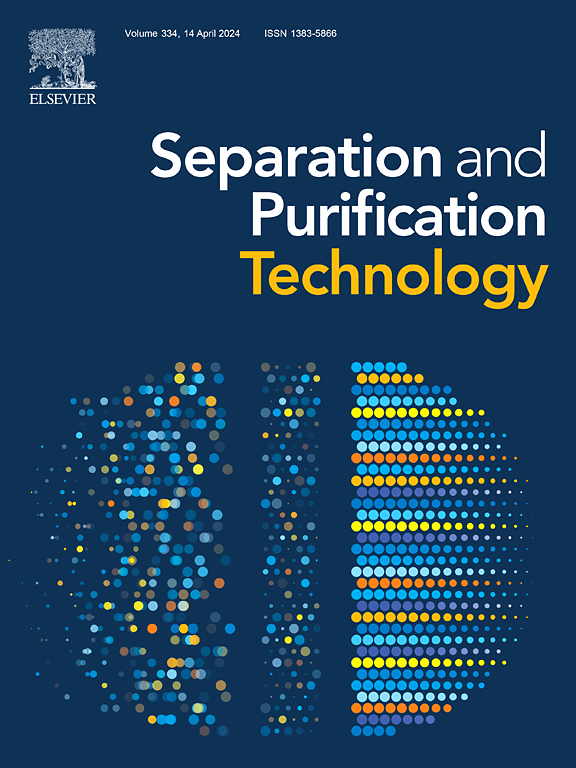集成CO2捕集和反水气转换的钙基双功能材料:通过分散的MgO-CaCO3界面促进储存的CO2加氢
IF 8.1
1区 工程技术
Q1 ENGINEERING, CHEMICAL
引用次数: 0
摘要
综合二氧化碳捕获和氢化的化学环原理已经显示出简化碳捕获过程和减少能源消耗的希望。然而,双功能材料的动力学限制阻碍了其实际应用。在这项工作中,我们研究了镁钙界面在理想的原料气条件下(CO2在氩气中,没有蒸汽或氧气)对提高CO2捕集和RWGS性能的协同效应。通过对Mg-to-Ca的比例进行微调,Mg0.12Ca0.36CO3的综合CO产量比常规CaO提高了8倍,在650 °C时达到9.54 mmol g−1。实验结果和机理研究表明,Mg的加入不仅增强了碳酸盐晶格在水气倒转反应中的稳定性,而且通过强化碱基位促进了CO2的高效加氢。界面位点有效激活储存的CO2,促进HCOO*中间体的形成,并通过脱氧将其转化为CO。理论计算进一步揭示了MgO-CaCO3界面在活化储存的CO2方面的优越性,证明了该界面稳定的CO2吸附和较低的H2解离障碍。这些发现强调了将Mg策略性地加入到基于caco3的DFMs中的潜力,作为一种可行的方法,可以提高实际应用中集成二氧化碳捕获和加氢的稳定性和效率。本文章由计算机程序翻译,如有差异,请以英文原文为准。


Calcium-based dual-functional materials for integrated CO2 capture and reverse water gas shift: Boosting stored CO2 hydrogenation via dispersed MgO-CaCO3 interfaces
The chemical looping principle of integrated CO2 capture and hydrogenation has shown promise for streamlining carbon capture processes and reducing energy consumption. However, the practical application is hindered by the kinetic limitations of dual functional materials (DFMs). In this work, we investigated the synergistic effect of the magnesium-calcium interface to enhance CO2 capture and RWGS performance under ideal feed gas conditions (CO2 in Argon without steam or oxygen). By fine-tuning the Mg-to-Ca ratio, Mg0.12Ca0.36CO3 exhibited an eightfold improvement in integrated CO production compared to conventional CaO, reaching 9.54 mmol g−1 at 650 °C. Experimental results and mechanistic studies revealed that the incorporation of Mg not only enhanced the stability of the carbonate lattice during the reverse water–gas shift reaction but also facilitated efficient CO2 hydrogenation by strengthening the basic sites. The interfacial sites effectively activate the stored CO2, promoting the formation of HCOO* intermediates and their subsequent conversion to CO via deoxygenation. Theoretical calculations provided further insights into the superiority of the MgO-CaCO3 interface for activating stored CO2, demonstrating stable CO2 adsorption and low H2 dissociation barriers at the interface. These findings highlight the potential of strategically incorporating Mg into CaCO3-based DFMs as a viable approach to enhance the stability and efficiency of integrated CO2 capture and hydrogenation in real-world applications.
求助全文
通过发布文献求助,成功后即可免费获取论文全文。
去求助
来源期刊

Separation and Purification Technology
工程技术-工程:化工
CiteScore
14.00
自引率
12.80%
发文量
2347
审稿时长
43 days
期刊介绍:
Separation and Purification Technology is a premier journal committed to sharing innovative methods for separation and purification in chemical and environmental engineering, encompassing both homogeneous solutions and heterogeneous mixtures. Our scope includes the separation and/or purification of liquids, vapors, and gases, as well as carbon capture and separation techniques. However, it's important to note that methods solely intended for analytical purposes are not within the scope of the journal. Additionally, disciplines such as soil science, polymer science, and metallurgy fall outside the purview of Separation and Purification Technology. Join us in advancing the field of separation and purification methods for sustainable solutions in chemical and environmental engineering.
 求助内容:
求助内容: 应助结果提醒方式:
应助结果提醒方式:


